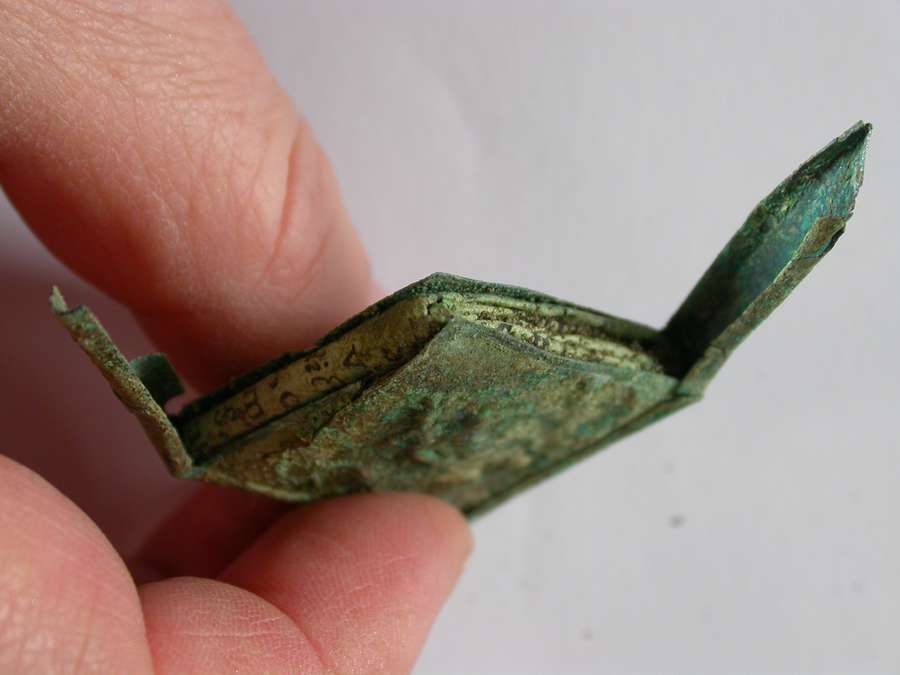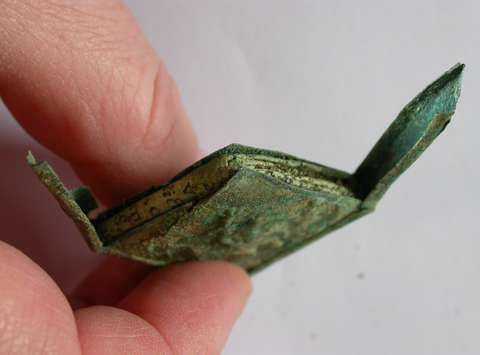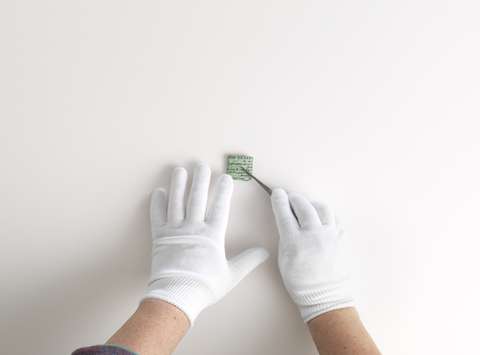Sealed medallion containing an incantation
Among the numerous archaeological discoveries on the site of the Church of St. Peter, in Njegoševa Street, a bronze medallion made from two thin bronze plates and an engraved shallow figural relief, attracted special attention from researches. Within the medallion, conservators discovered a folded piece of paper, which proved to be a protective text against curses. Are you curious what it says? Find out in the Treasury of the City Museum of Ljubljana.
KNOWN FOR ITS RICH HISTORY, THE CHURCH OF ST. PETER in Njegoševa Street is one of the oldest parish churches in Ljubljana, most probably built at the end of the Early Middle Ages. First mentioned in written sources in 1262, the church was reportedly the base of the first Ljubljana parish priest whose name (Peter) is known. This priest was mentioned in a document dated 1163.
In the course of excavation work carried out in 2011 as part of the reconstruction of the public utility pipes in Njegoševa Street, nearly 900 graves were documented: in addition to the older, Slavic graves, approximately 650 graves dating to between the 12th and 18th centuries were discovered. The deceased had been buried in wooden coffins, along with grave goods that included jewellery, objects intended for everyday use (pins, brooches, necklaces, rings, etc.), and objects of a religious nature (shrines, crosses, rosaries etc.). The most notable of the finds was a medallion made of two thin bronze plates featuring a figural bas-relief, which was unearthed from an inhumation grave.
WHEN THEY INSPECTED THE MEDALLION, THE CONSERVATORS AND RESTORERS OF THE MUSEUM AND GALLERIES OF LJUBLJANA HAD GOOD REASON TO BE SURPRISED: it contained a sheet of paper folded over several times. Since the paper document had been sealed into the metal medallion, and the medallion could not be opened, it was very well preserved.
Different conservation approaches were required for the two different materials (bronze and paper) used for the object. The paper document was therefore separated from the bronze casing and removed from the medallion. It was amazingly well preserved! Other than the green bronze patina marks on the front and back of the folded document, it was practically undamaged. The document was placed in a humidification chamber to increase its relative humidity and make it more flexible.
In this way, the conservators were able to prevent the fibres from breaking and made it possible to unfold the paper without the risk of damage. Once the unfolded document had been photographed, it was folded back into its original form. The metal casing, which was covered with unstable patina and soil, was mechanically cleaned using a needle scaler and a scalpel.
Martin Horvat, Head of Archaeological Excavations, Museum and Galleries of Ljubljana
Katarina Toman Kracina, Head of Conservation Service, Museum and Galleries of Ljubljana
A PRAYER AGAINST ALL EVILS, INCLUDING DEMONS
(Lat. Oratio contra omnes tum maleficorum tum daemonum incursus)
The printed Latin text is an example of a Breverl (Latin breve, meaning “short text”), a short text printed on a folded sheet of paper, usually consisting of incantations, spells and magic formulas (e.g. for protection), along with holy images and depictions of saints. Breverls were usually kept in costly cases made of precious fabrics, sometimes with a metal casing; various devotional items (devotionalia), such as holy objects, have often been found with them.
The text of this incantation seems to be pan-European, i.e. known across Europe. This is borne out by other preserved examples found in several European libraries, archives and cabinets of curiosities. It is impossible to trace the exact origins of the text. It was probably created by the Jesuits, in the 16th century, and later reprinted by various printers. It also found its way into a number of manuals for blessings, exorcisms, etc.
This copy was printed by the Mayr printing house, though the precise date can only be guessed at.
This family printing house was founded by Johann Baptist Mayr, who came to Ljubljana in 1678 on the recommendation of Janez Ludvik Schönleben and at the invitation of the Carniolan provincial estates. He was succeeded by his son Tadej, who died in 1695. Tadej’s widow, Ana Barbara, then ran the print shop until 1705, when it was taken over by Janez Jurij (died 1733). Janez Jurij is also the printer named at the foot of the document, which suggests that the text was printed between 1705 and 1733. This version must have been copied, though either the copyist or typesetter made a number of mistakes in his work.
Location
Gosposka 15
1000 Ljubljana
Information and reservations:
T: +386 1 2412 500
T: +386 1 2412 506
E- mail: info@mgml.si, prijava@mgml.si
Opening hours
Tuesday–Sunday: 10.00–18.00
Mondays, 1 January, 1 November and 25 December: Closed
Tickets
Permanent exhibition Ljubljana. History. City. (basement and 2nd floor)
Solo visit: € 8 / reduced (children from the age of 7, students, over 60, unemployed, disabled): €6
Family ticket: 18€
Public guided tour: € 9.00 / reduced: € 7.00
Children up to the age of 6, ICOM, PRESS, SMD, disabled companions, tourist URBANA, licensed tourist guide: free of charge


